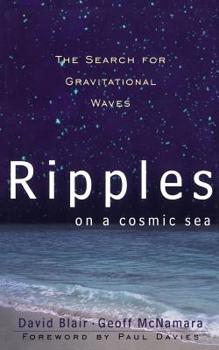Ripples on a Cosmic Sea: The Search for Gravitational Waves (Frontiers of Science (Addison-Wesley))
Select Format
Select Condition 
Book Overview
Most people live and work entirely oblivious to the fact that a myriad of ghostly ripples are passing through them all the time. Generated in the depths of space by colliding stars and black holes,... This description may be from another edition of this product.
Format:Paperback
Language:English
ISBN:0738201375
ISBN13:9780738201375
Release Date:April 1999
Publisher:Basic Books
Length:224 Pages
Weight:0.55 lbs.
Dimensions:0.7" x 5.2" x 8.1"
Customer Reviews
5 ratings
Great exposition
Published by Thriftbooks.com User , 15 years ago
Please don't be discouraged from reading this book by some of the criticisms found here. This book is actually amazing in it's ability to describe general relativity and curved space-time in terms that a layperson can understand. The subject of the book is Gravitational Waves, but before it gets to that, it spends some time describing, with crystal-clear writing, Newton's vs. Einstein's gravity theories, presenting numerous analogies so that readers with no math background can get an inkling of what curved space-time really is. Couple this with the infectious enthusiasm with which the authors write, and you get a book that is (at least for me) un-put-down-able. Finishing this book you will almost certainly have a deeper understanding of gravity. I even recommend this book for people who have some knowledge of the mathematics of general relativity because there just might just be a new way of conceptualizing things that they might find here.
Gravitational Waves
Published by Thriftbooks.com User , 16 years ago
A well-written, easy to understand book, which introduces the lay person to the theories of gravity and gravitational waves.
Ripples on a Cosmic Sea.
Published by Thriftbooks.com User , 19 years ago
Overall this is an excellent treatment of a little considered but intriguing problem of physical theory, the direct observation of gravitational waves. Such waves seem to be demanded by Einstein's gravitational theory, general relativity, but, as gravity is by far the weakest of the fundamental forces, it is a phenomenon that presents great difficulty in terms of direct detection. In trying a little too hard to build interest in their thesis, the authors conjure a small blunder early on, but once they 'get down to business' the book unfolds as an exceptionally well-told story. The first chapter blunder is not particularly important to the thesis and many readers won't even notice it, so I'll return to it only as a closing thought, and only in the interest of defending science from misleading oversimplifications. Paul Davies' foreword and the authors' prologue should not be missed, and when Blair and McNammara hit their stride, discussing the gravitational curiosities that are quite commonplace in our universe -- supernovae, black holes, white dwarfs, and neutron stars, especially pulsars which lend themselves so well to close mathematical examination -- the text is outstanding. The discussion of the processes that produce these objects is a real page-turner as is the examination of the objects themselves: A densely massive binary pulsar traveling at one-sixth the speed of light! Emitting the gravitational wave 'luminosity' of a hundred thousand galaxies! Talk about energy! If we could examine the gravitational wave spectrum, what kind of information might we glean? No one knows, but Blair and others want to. The text does become less interesting in protracted discussions of the mechanics and sensitivities of instruments employed in the search for gravitational waves and the myriad technical difficulties and challenges involved. Okay, about that blunder: In a first chapter derision of "lies" taught "at school," the authors lament that students are taught "lies" about the correct nature of space-time, as opposed to other areas of scientific interest in which schools are said to teach "the truth." With uncharacteristic carelessness it is said that we are taught "the truth" about "the solar system," about "atoms," and about the biological "evolution of species." As a matter of sober epistemological integrity, such cavalier statements create an unwarranted mess. How can we teach "the truth" about the solar system if we are teaching "lies" about space-time?! Is "the truth" about atoms the so-called objective particles of the standard model or, are "particles" really field oscillations, the vibration patterns of string/M theory? Are "atoms" classical physical objects or pragmatic mathematical abstractions of 'something' rather 'immaterial'? Is "the truth" about biological evolution "the truth" of C. Darwin, "the truth" of L. Margulis, or "the truth" of S. Kaufmann? Is "the truth" of the evolution of species what R. Dawkins believes it to be, or is it
glossary anyone?
Published by Thriftbooks.com User , 25 years ago
This book would have greatly benifited from the inclusion of a glossary. Any work covering a subject this complex needs definitions set out and collected together. The publisher's given web site was unavailable.
Please produce an audio adaptation ...
Published by Thriftbooks.com User , 25 years ago
To the publisher I would appreciate it if the publisher could produce an audio adaptation of this book. I would love to listen to this while I drive to work and to let my 16 month old son listen to it as a bedtime story. Arnold D Veness






